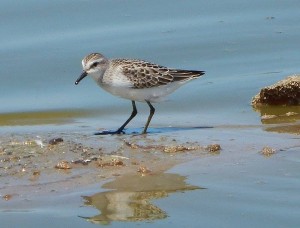
Shorebirds occupy remnant wetlands and the mud flats around our lakes and reservoirs. The largest numbers occur during migration, when they pass through the Valley on their way to southern wintering grounds. Some also winter here.
The larger species are the best known. Black-necked Stilts, American Avocets, and Greater Yellowlegs are often seen and sometimes even known by name.
The “peeps” are another story. Small, brown or gray, and wary of people, most of these little shorebirds are noticed only when a flock wheels into the air and all the birds turn at once, flashing bright white underparts. Otherwise, they’re just small forms scurrying back and forth on the mud.
It’s up to the hard-core birders take on the challenge of identifying the smaller shorebirds, first from a desire to add another species to their list of “life birds,” then often as a test of concentration, attention to detail, and inference-making.
At only five or six inches in length, many species can be separated only by subtle differences in bill shape and plumage details. Ralph Baker was reviewing such details last Sunday, when he and three other members of Stanislaus Audubon Society were conducting a bi-weekly bird survey on restricted-access property near Patterson.
One member of the group thought he’d seen a very rare Semi-palmated Sandpiper on an exposed mud flat in a large pond. The bird had flown before anyone got a definitive look, and Baker was eager to relocate it and add it to his life list.
After much searching, the birders found a bird similar to the one they’d seen earlier, and Baker got a couple of blurry photos that suggested the bird in question might indeed be a Semi-palmated Sandpiper. Unfortunately, there was also the possibility it could be the common variety hereabouts, the Western Sandpiper. While a tentative consensus formed that the bird in question was most likely a Semi-palmated rarity, everyone was a bit uneasy with the final brief glimpses and blurry photos.
The next day, Baker was looking for shorebirds in Ceres when he encountered one of the birders from the previous day’s party. Baker learned that the birder had seen a “for sure” Semi-palmated Sandpiper, but the bird had flown before he could get a picture.
Intrigued by the possibility of getting a really good look after the previous day’s frustration, Baker spent the next ninety minutes searching for the elusive shorebird. Just as he was about to leave, he spotted the bird on a mud flat with a few other birds.
Despite its tiny size and active foraging, Baker was able to get a number of excellent photos of the Semi-palmated Sandpiper, a bird seen in Stanislaus County only once or twice a decade. Now he had conclusive evidence of a very rare “life bird,” and bragging rights to some of the best photos ever of a seldom-seen visitor—a great day’s birding in every way.
